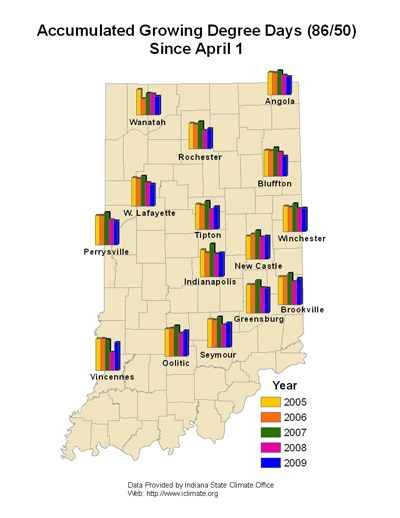Pest & Crop Newsletter, Entomology Extension, Purdue University
Get to the Root(worm) of the Problem - (Christian Krupke, John Obermeyer, and Larry Bledsoe)
- High-risk fields should be evaluated for rootworm larvae and damage.
- Insecticide efficacy on early-planted corn may be suspect.
- Larval sampling procedures are outlined.
- Rescue treatment guidelines are given below.
Rootworm larvae have been hatching and seeking corn roots for a few weeks in northern counties and even longer in southern counties. When first hatched the larvae are seldom observed because they are very small and live mostly within the roots. As they increase in size, they will feed both inside and outside roots, causing tunneling and pruning. It would be prudent to sample roots of plants in high-risk fields, especially where insecticide efficacy is in question.
High tech tools for rootworm sampling
To sample for rootworms, use a shovel and lift out the root mass and surrounding soil and place on a dark surface (black plastic garbage bags work well). Carefully break up the clods and sort through the soil. Look for 1/4 to 1/2 inch long, slender, creamy-white larvae with brownish-black heads and tails. Once the soil has been separated from the root mass, inspect it for root scarring and pruning. You may find the larvae under the leaf collars that are close to nodal roots; tear these leaves away to check. Rootworms are often observed sticking out of roots. Repeat the process with several plants, representing different areas of a field. An average of two or more larvae per plant represents a rootworm population and signals the need for a rescue cultivation application.
The damaged roots on the left isn't noticeable until the plant falls over
Insecticides applied after planting should be directed toward the base of the plant. It is also important to throw soil up around plants to incorporate the insecticide and promote the establishment of brace roots. A good brace root system will help prevent plant lodging and reduce yield losses due to rootworm feeding. If a no-till field has an economic population of larvae, placing the insecticide on top of the ground will usually not be effective. The only exception may be if the soil insecticide is watered in through irrigation or rainfall (ideally ½” or more). Two liquid soil insecticides, Furadan 4F (2009 is the last year for use of this product) and Lorsban 4E, are labeled for post-emergent applications. If one decides to mix the insecticide with a liquid nitrogen source for a side-dress application, compatibility checks should be made. Broadcasting the insecticide will greatly diminish rootworm efficacy.
Click on the above link to watch this movie on scouting for corn rootworm larvae
![]()
Leafhopper Populations Booming - (Christian Krupke, and John Obermeyer)
- Regrowth is most at risk for feeding damage.
- Damage has already occurred once "hopper burn" is noticed.
Populations of potato leafhopper in alfalfa fields have been rising throughout the state. There have been observations of high numbers of leafhoppers coming to lights at night. Undoubtedly, the extended hot temperatures have contributed to this population explosion.
Hopper burn, means damage is done
Producers are encouraged to inspect new growth soon after cutting for potato leafhopper; this is when alfalfa is most susceptible to feeding, leading to reduced yields and protein levels. Remember, once yellowing or “hopper burn” is seen, the damage has already been done. Refer to E-220-W, Alfalfa Insect Control Recommendations – 2009 <http://extension.entm.purdue.edu/publications/E-220.pdf>.
![]()
Click here to view the Black Light Trap Catch Report






